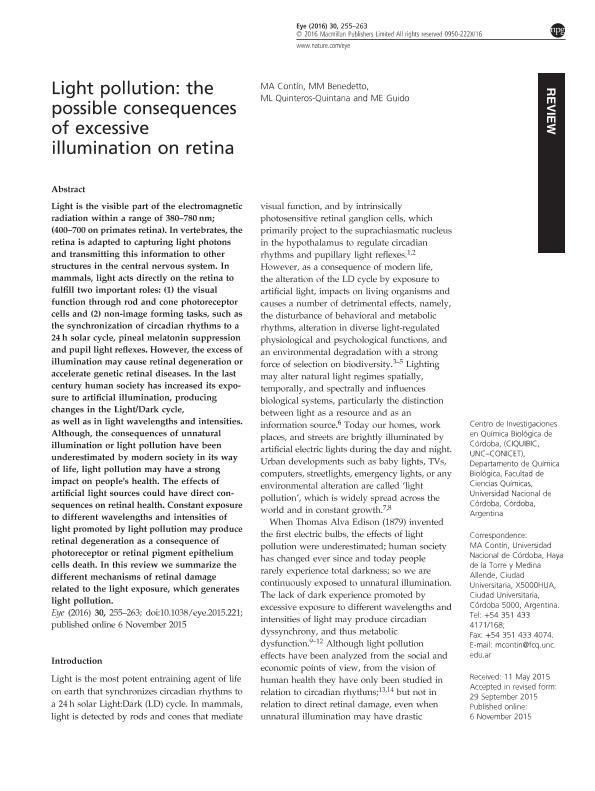Artículo
Light pollution: The possible consequences of excessive illumination on retina
Fecha de publicación:
02/2016
Editorial:
Nature Publishing Group
Revista:
Eye
ISSN:
0950-222X
e-ISSN:
1476-5454
Idioma:
Inglés
Tipo de recurso:
Artículo publicado
Clasificación temática:
Resumen
Light is the visible part of the electromagnetic radiation within a range of 380-780 nm; (400-700 on primates retina). In vertebrates, the retina is adapted to capturing light photons and transmitting this information to other structures in the central nervous system. In mammals, light acts directly on the retina to fulfill two important roles: (1) the visual function through rod and cone photoreceptor cells and (2) non-image forming tasks, such as the synchronization of circadian rhythms to a 24 h solar cycle, pineal melatonin suppression and pupil light reflexes. However, the excess of illumination may cause retinal degeneration or accelerate genetic retinal diseases. In the last century human society has increased its exposure to artificial illumination, producing changes in the Light/Dark cycle, as well as in light wavelengths and intensities. Although, the consequences of unnatural illumination or light pollution have been underestimated by modern society in its way of life, light pollution may have a strong impact on people's health. The effects of artificial light sources could have direct consequences on retinal health. Constant exposure to different wavelengths and intensities of light promoted by light pollution may produce retinal degeneration as a consequence of photoreceptor or retinal pigment epithelium cells death. In this review we summarize the different mechanisms of retinal damage related to the light exposure, which generates light pollution.
Palabras clave:
Retina,
,
Photoreceptors
,
Retinal Degeneration
,
Light Damage
,
Light Pollution
Archivos asociados
Licencia
Identificadores
Colecciones
Articulos(CIQUIBIC)
Articulos de CENTRO DE INVEST.EN QCA.BIOL.DE CORDOBA (P)
Articulos de CENTRO DE INVEST.EN QCA.BIOL.DE CORDOBA (P)
Citación
Contin, Maria Ana; Benedetto, María Mercedes; Quinteros Quintana, María Luz; Guido, Mario Eduardo; Light pollution: The possible consequences of excessive illumination on retina; Nature Publishing Group; Eye; 30; 2; 2-2016; 255-263
Compartir
Altmétricas




